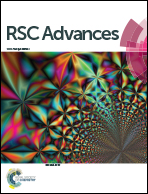Profiling of co-metabolic degradation of tetracycline by the bio-cathode in microbial fuel cells†
Abstract
In this paper, a system of tetracycline (TEC) degradation by the bio-cathode in a microbial fuel cell (MFC) was constructed. Overall, the co-metabolic degradation performance of TEC was studied through single factor experiments and the ecological risk was evaluated using the E. coli growth inhibition rate and resistance genes. High throughput sequencing (HTS) was utilized to profile the biofilm community structure of the bio-cathode. Results showed that the degradation rate of TEC reached greater than 90% under optimal conditions, which was 10 mg L−1 initial TEC concentration, 0.2–0.7 g L−1 sodium acetate concentration and 12–18 L h−1 aeration. Furthermore, compared with the aerobic biodegradation of TEC, the degradation efficiency of the MFC bio-cathode for TEC was significantly increased by 50% and the eco-toxicity of TEC after 36 hour degradation was reduced by 60.9%, and TEC ARGs in effluent were cut down. HTS results showed that electrochemically active bacteria Acetobacter and TEC-resistant degradation bacteria Hyphomicrobium, Clostridium and Rhodopseudomonas were the main dominant bacteria in the cathode biofilm. Besides, based on 5 intermediates, degradation pathways involving deamidation, denitro dimethylation, dedimethylation and dehydroxylation of TEC were proposed. The degradation of TEC on the bio-cathode was mainly caused by microbial co-metabolism action. This study would enrich the study of MFC bio-cathodic degradation of antibiotics in water.



 Please wait while we load your content...
Please wait while we load your content...